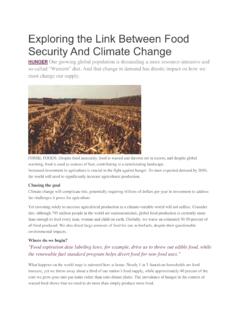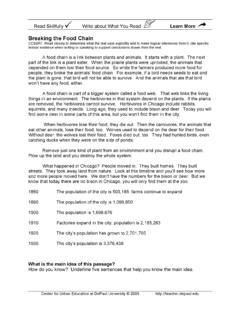Transcription of Understanding the Connections: Food Insecurity and Obesity
1 October 2015 While all segments of the population are affected by Obesity , food insecure and low-income people can be especially vulnerable due to the additional risk factors associated with inadequate resources and under-resourced communities. This brief first will highlight research on food Insecurity and Obesity , and then explore why food Insecurity and Obesity can co-exist. What Does the Research Say About food Insecurity and Obesity ?The extent of research on food Insecurity and Obesity has grown considerably since 1995, when a leading pediatrician published a medical case report that proposed a relationship between hunger and At first, the relationship between food Insecurity and Obesity was considered counterintuitive and labeled a paradox. This was due, in part, to our limited Understanding of the causes and consequences of food Insecurity .
2 But now, with a more extensive research base and comprehensive conceptual framework, researchers conclude that the coexistence of food Insecurity and Obesity is expected given that both are consequences of economic and social disadvantage. 2 While food Insecurity and Obesity can co-exist in the same individual, family, or community, the research on whether there is a statistically significant relationship provides mixed ,4,5,6 A number of research studies in the and abroad have found positive associations between food Insecurity and overweight or Obesity . Other studies have found no relationship, or even a lower risk of overweight or Obesity with food Insecurity . Associations, or lack thereof, often differ by gender, age, and/or race-ethnicity. Making comparisons across studies is further complicated by differences in study design, measures of weight and food security status, and sample size and characteristics.
3 Overall, based on several reviews of the literature, the strongest and most consistent evidence is for a higher risk of Obesity among food insecure the Connections: food Insecurity and ObesityA selection of recent studies is provided below that demonstrate the mixed findings on the relationship between food Insecurity and Obesity . The majority of these studies control for socioeconomic factors ( , income, education) as well as demographic characteristics ( , age, gender, race-ethnicity). Research Examining food Insecurity and Obesity among Adults A study of more than 7,930 adults found that household food Insecurity was associated with being overweight or obese among mothers, but not among fathers, child-free women, or child-free (Researchers determined that this pattern among mothers was not attributable to pregnancy-related metabolic changes.)
4 In a 12-state study of 66,553 adults, those who were food insecure had 32 percent greater odds of being obese compared with those who were food Obesity was significantly associated with food Insecurity among the following five population sub-groups: women (but not men); those with some college education or who graduated from college; and those with no children or two children in the household. food Insecurity was associated with increased body mass index (BMI) among young women, but not young men, in a national study of more than 13,700 young adults 24 to 32 years of food Insecurity was associated with a greater increase in BMI in a longitudinal study of more than 2,400 patients at a Massachusetts community health Female baby boomers and older adults who were food insecure were times more likely to have a higher BMI than those females who were food secure, based on a study set in an eight-county region of central Texas with 2,985 No association between food Insecurity and BMI was observed among male participants.
5 In a study of 810 pregnant women in North Carolina with incomes less than or equal to 400 percent of the income/poverty ratio, living in a food insecure household was associated with being severely obese before pregnancy and with experiencing greater weight gain during Additional studies have found links between food Insecurity during pregnancy and greater postpartum weight and BMI, particularly among women who were obese before or during ,14 Research Examining food Insecurity and Obesity among Children and AdolescentsThe following results for children and adolescents are less consistent than the studies for adults described above, which typically found a consistent relationship between Obesity and food Insecurity among adult women, but not men. Across five measures of Obesity ( , BMI, waist circumference, triceps skinfold, trunk fat mass, and percentage of body fat), one study found no association between household food Insecurity status and Obesity among a national sample of 2,516 low-income children 8 to 17 years of Young people 12 to 18 years of age from marginally food secure, low food secure, and very low food secure households were to times more likely to have central Obesity than those from high food secure households, based on national survey data from 7,435 Those from low food secure and marginally food secure households also were significantly more likely to be overweight than their counterparts from high food secure households.
6 A three-city study (Boston, San Antonio, and Chicago) of 1,011 low-income adolescents found that maternal stress in combination with adolescent food Insecurity significantly increased an adolescent s probability of being overweight or According to a longitudinal study of more than 28,000 low-income children in the Massachusetts WIC program, persistent household food Insecurity without hunger during infancy and early childhood was associated with 22 percent greater odds of child Obesity at two to five years of age, in comparison to children from persistently food secure These odds varied with the mother s pre-pregnancy weight status: children from households with persistent food Insecurity without hunger were three times more likely to be obese if the mother was underweight and 34 percent more likely to be obese if the mother was overweight or obese, when compared to children from persistently food secure households; no association was found if the mother had a normal pre-pregnancy weight status.
7 A smaller study of 222 young, predominantly Hispanic children whose caregivers were receiving WIC services found no association between overweight or Obesity and household food security Understanding the Connections: food Insecurity and ObesityPage 2 Why Can food Insecurity and Obesity Co-Exist? That food Insecurity and Obesity can co-exist and are significantly associated in some studies does not necessarily mean they are causally linked to each other. Both food Insecurity and Obesity can be independent consequences of low income and the resulting lack of access to enough nutritious food or stresses of poverty. More specifically, Obesity among food insecure people as well as among low-income people occurs in part because they are subject to the same often challenging cultural changes as other Americans ( , more sedentary lifestyles, increased portion sizes), and also because they face unique challenges in adopting and maintaining healthful behaviors, as described below.
8 Limited Resources and Lack of Access to Healthy, Affordable Foods Low-income neighborhoods frequently lack full-service grocery stores and farmers markets where residents can buy a variety of high-quality fruits, vegetables, whole grains, and low-fat dairy ,21,22 Instead, residents especially those without reliable transportation may be limited to shopping at small neighborhood convenience and corner stores, where fresh produce and low-fat items are limited, if available at all. Comprehensive literature reviews examining neighborhood disparities in food access find that neighborhood residents with better access to supermarkets and limited access to convenience stores tend to have healthier diets and reduced risk for ,24 According to USDA, vehicle access is perhaps the most important determinant of whether or not a family can access affordable and nutritious food .
9 25 Households with fewer resources ( , SNAP households, WIC households, food insecure households) are considerably less likely to have and use their own vehicle for their regular food shopping than those households with more food choices and purchases may be constrained by limits on how much can be carried when walking or using public transit ( , buying fewer items in bulk or that are heavy), or if consumers are limited to one large shopping trip a month with a friend or family member to buy the majority of their monthly food purchases ( , buying fewer perishable items like fresh produce).27,28 Transportation costs also cut into the already limited resources of low-income households, and these costs plus travel time can be ,30 When available, healthy food may be more expensive in terms of the monetary cost as well as (for perishable items)
10 The potential for waste, whereas refined grains, added sugars, and fats are generally inexpensive, palatable, and readily available in low-income ,32,33,34 Households with limited resources to buy enough food often try to stretch their food budgets by purchasing cheap, energy-dense foods that are filling that is, they try to maximize their calories per dollar in order to stave off ,36,37 While less expensive, energy-dense foods typically have lower nutritional quality and, because of overconsumption of calories, have been linked to ,39 When available, healthy food especially fresh produce is often of poorer quality in lower income neighborhoods, which diminishes the appeal of these items to ,41 Low-income communities have greater availability of fast food restaurants, especially near ,43,44 These restaurants serve many energy-dense, nutrient-poor foods at relatively low prices.
















